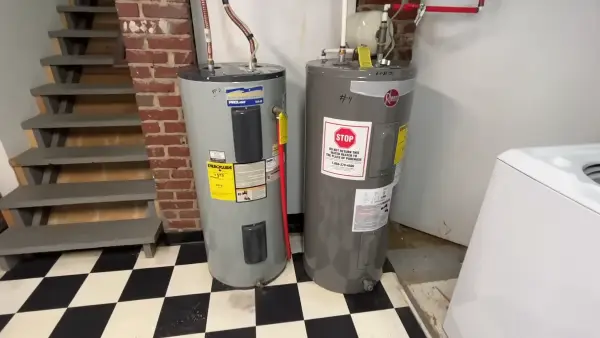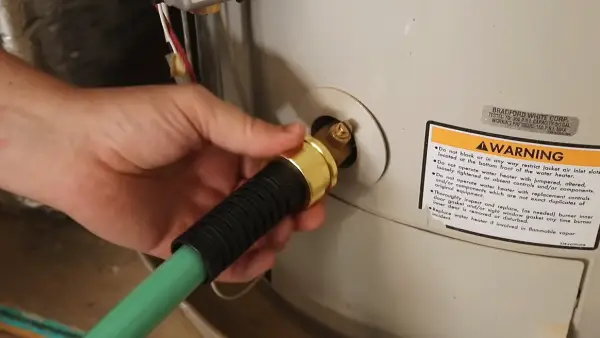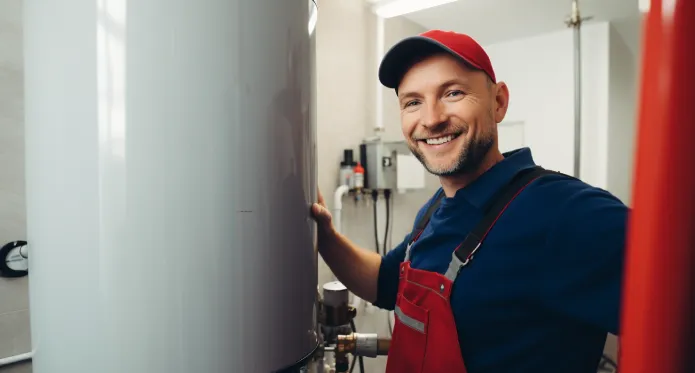Last Updated on September 6, 2023
Flushing and cleaning mineral buildup and debris is essential for ensuring the efficiency and longevity of your electric water heater to function optimally. But how much does it cost to flash and clean an electric water heater?
You can expect to pay between $75 and $250 (or an average of $160) to have your electric water heater flushed and cleaned by a professional. While it is possible to do it yourself, hiring a specialist ensures the job is done effectively and efficiently.
The cost of the service may vary depending on factors such as necessary materials, labor, and level of expertise required. Whether you’re a DIY enthusiast or prefer to leave it to the pros, here’s a complete guide to cleaning and flushing your tankless water heater. So keep reading for serious savings.
How to Flush and Clean Your Electric Water Heater by Yourself: Possible 7 Steps

You can flush and clean the tankless water heater yourself if you have some plumbing experience, such as removing sediment and cleaning all parts. Follow these step-by-step processes to flush and clean your electric tankless water heater.
- Step 1: Turn off Electricity and the isolation valves
- Step 2: Gather necessary equipment and connect hoses
- Step 3: Attach hoses to the water circulation pump
- Step 4: Add a cleaning agent
- Step 5: Open the valves and start the circulation
- Step 6: Remove the cleaning agent from the system
- Step 7: Reconnect and restore the valves and electricity
Step 1: Turn Off Electricity and the Isolation Valves
Locate the isolation water valves attached to your tankless water heater and turn them off by rotating them perpendicular to the pipes. The blue inlet valve is for cold water, while the red outlet valve is for hot water. It’s important to ensure that both valves are completely closed to prevent potential leakage.
Next, you need to turn off the power source of the heater. Follow the same steps as the isolation valves, ensuring they are disconnected.
Step 2: Gather Necessary Equipment and Connect Hoses
Ensure you have all the necessary equipment, like hoses, a circulation pump, a bucket, and a cleaning agent or vinegar. These items are essential for effectively flushing and cleaning your electric water heater.
The circulation pump is typically provided in flushing kits and helps to move water through the system for thorough cleaning.
Step 3: Attach Hoses to the Water Circulation Pump
Attach one end of the hoses to the circulation pump, ensuring a secure connection for effective water movement. This is crucial in facilitating water flow through the system during the flushing and cleaning.
Begin by selecting hoses compatible with the circulation pump with appropriate lengths to reach all necessary connections. Carefully attach one end of each hose to the designated inlet and outlet ports on the circulation pump, ensuring they are tightly secured to prevent any leaks or disruptions in water flow.
Double-check that all connections are properly aligned and fastened to ensure optimal performance.
Step 4: Add a Cleaning Agent
Once you’ve secured the pipes to the circulation pump, it’s time to add the appropriate amount of cleaning agent into the bucket. Ensure you have at least one gallon of water in the bucket before adding the cleaning agent.
Using the correct amount of cleaning agent for effective results is important. If you are using a commercial cleaning agent, follow the manufacturer’s instructions for dosage. But vinegar can be used as a substitute if you don’t have a commercial cleaning agent.
Remember that vinegar requires a longer circulation time for proper cleaning, so you must use 2-3 gallons of vinegar diluted with water.
Step 5: Open the Valves and Start the Circulation
To begin circulation, open both water valves and turn on the pump. This will allow water to flow through the system and start cleaning. Make sure that both valves are fully open to ensure proper water flow.
Once the valves are open and the pump is running, you can observe the water circulating through the pipes and tank of the electric water heater.
The circulation time may vary depending on your cleaning agent, so refer to your chosen cleaning agent’s instruction booklet for specific recommendations. However, it is recommended to let the circulation continue for at least 15 to 45 minutes to clean the system effectively.
Step 6: Remove the Cleaning Agent from the System
Disconnect the hose from the hot water outlet valve and allow the leftover cleaning substance or vinegar to be flushed out by turning on the cold water incoming valve.
Turning on the cold water valve will initiate this flushing process as fresh water enters the system and expels the cleaning agent or vinegar.
Let this process continue for approximately 5 to 10 minutes, allowing enough time for thorough flushing.
Step 7: Reconnect and Restore the Valves and Electricity
After flushing the water, reattach the service port caps removed during cleaning. Once the caps are securely placed, turn on the water valves and the power supply.
Make sure these valves are fully open to restore the proper operation of your tankless water heater. It is crucial to follow this step carefully, as improper valve settings can lead to inefficient heating or damage to your unit.
How long will it take to flush a hot water heater?

Depending on the size of your water heater, it will take you anywhere from 15 to 60 minutes to flush it. The time it takes to flush the tank can vary based on factors such as the amount of sediment buildup and the efficiency of your flushing method.
Larger tanks typically require more time (2 hours) due to increased capacity. It’s important to note that this estimated time does not include the cooling down period for the water in the tank, which can take several hours.
Extend the Lifespan of Your Electric Water Heater with Routine Flushing & Cleaning
Regular maintenance extends the working life of your electric water heater unit and ensures efficient operation. By taking the time and effort to maintain your appliance, you’ve ensured its optimal performance.
The cost of this essential task may vary depending on the service provider, but it’s a small investment compared to the potential consequences of neglecting your water heater. While DIY flushing is possible, hiring an expert is advisable to ensure the task is completed correctly if you’re uncomfortable with tools or the process. Also, routine flushing, ideally once a year, can significantly extend the life of your water heater and help it perform at its best. So keep up the good work, and enjoy hot showers with peace of mind.

